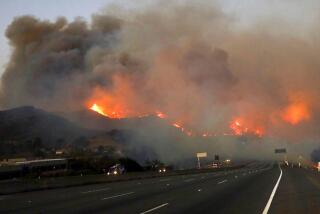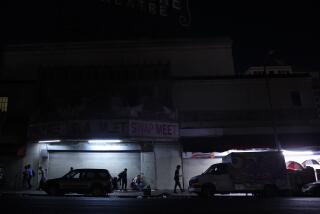Cleaning Up City Terrace Crime
On a clear day in City Terrace, residents say they can see Santa Catalina Island. But most of the time, what they see up close is a lot more unsightly--gangs, drugs, graffiti, prostitution and even speeding taxis careening down narrow streets of their East Los Angeles neighborhood, close to the San Bernardino Freeway.
“I know the difference between a clean, quiet neighborhood and City Terrace,” said resident Esther Rodriguez, 50, who, after a while in the San Fernando Valley, came back to City Terrace. “It is frustrating to live here.”
The Los Angeles County Sheriff’s Department admits that City Terrace has historically been a notorious crime area. So the department has decided to use an increasingly popular approach--community-based policing--to try to turn around the tough neighborhood. It will assign a full-time task force of one sergeant and 18 deputies to City Terrace, far more than the three to four squad cars that normally patrol the 39,000-resident area. The task force has a simple goal: Identify community concerns and solve them through beefed-up enforcement.
Community policing doesn’t involve just uniformed deputies. Other government components, such as building inspectors, traffic monitors and juvenile experts, are part of the effort. And the involvement of volunteer citizen groups, such as the City Terrace Coordinating Council, is an important element.
The campaign, which may last a year or more, will officially get underway Feb. 12 with door-to-door canvassing. A community meeting will be held later to review the canvassing’s results.
Violent crime is likely to be a recurrent theme in those discussions. The incidents of reported murder, rape, assault and robbery in City Terrace numbered more than 400 in the first 11 months of 1999, significantly more than in other parts of East Los Angeles.
Already, there are some encouraging signs since the crackdown unofficially began late last year. Arrests in the seven-square-mile area, across the freeway from the Cal State L.A. campus, nearly tripled, jumping from 54 in December 1998 to 155 last December. Also, residents report that deputies are responding to calls for assistance more promptly than in the past.
“These guys are dynamite,” apartment owner Diana Tarango said of the deputies in City Terrace.
Eventually, an image that few in City Terrace can fathom--deputies on foot and on bikes--may become part of the community policing effort there.
Community policing is an increasingly popular method of attacking age-old crime problems, and the Sheriff’s Department in recent years has used the approach--thanks to about $32 million in federal funds--in areas stretching from Altadena to the Willowbrook section of South-Central with varying degrees of success.
In the five years since the department embraced the community policing approach in targeted areas, officials say crime has gone down, more neighborhood watch groups have formed and residents’ view of law enforcement has improved markedly.
That has coincided with an overall downturn in violent crime in Los Angeles County and across the United States.
Residents stress that there’s a lot to be proud of in City Terrace. Among the positives are education programs for youngsters and adults, the establishment of a local branch of the county library system, active churches and the paving and regular sweeping of more of the area’s streets.
Nevertheless, City Terrace will be a difficult test, given its long history of gang problems and the lack of a municipal infrastructure to deal with local issues. The hilltop area is part of unincorporated East Los Angeles.
One ranking sheriff’s official thinks it could take years to plant the seeds of real change.
“Is six months enough time?” asks Natalie Macias, director of the sheriff’s community policing program. “No. Is a year enough time? No. You can’t just walk in and expect everything to change. It may take five years . . . or 10. We have to start someplace.”
City Terrace, now a blue-collar district of mostly Mexican American families, was once a rural oasis in the midst of a growing metropolis. Before World War II, it was home for many prominent Jewish merchants who commuted to their shops in nearby Boyle Heights. From hilltop homes, residents reveled--and still do--in the sweeping views spanning from the hills of Monterey Park to the ocean.
Beginning in the 1950s, however, the urbanization of Los Angeles changed City Terrace. Crime became more prevalent, spurred on, in part, by the area’s proximity to jail facilities--the men’s jail downtown and the nearby Sybil Brand Institute for women. Authorities say just-released inmates ended up in the area and caused trouble.
The narrow, winding streets, once regarded as quaint, became clogged with traffic.
At least three major street gangs have been rooted there for many years and, despite the best efforts of the Sheriff’s Department, still hold sway in parts of City Terrace. Some refer to the gangs as “hill people,” a grudging acknowledgment that they have become a part of City Terrace’s fabric.
Cecilia Berrara, who has lived on Hazard Avenue for more than 10 years, said gang members and their associates moved into homes on either side of hers and became noisy, trashy neighbors. Drug dealing was a common occurrence. Abandoned houses became targets for vagrants and graffiti.
“It got so bad that you couldn’t even walk to the neighborhood store without getting propositioned by these people,” she said.
Rodriguez, another longtime City Terrace resident, said gangs routinely use De Garmo Drive, the street she lives on, to elude pursuing deputies because of its hilly inaccessibility.
Other problems, such as neighbors who discard motor oil down street gutters, persist. On De Garmo, competitive taxi drivers, who park on the elevated street to intercept radio calls, race downhill to beat others to fares.
During a sting operation earlier this month, deputies seized 10 taxis, cited the drivers and took one man into custody. Rodriguez praised the effort, but said the drivers snared “were only the tip” of the problem.
The biggest challenge facing the sheriff’s task force may be convincing City Terrace folks that they really mean business and that they will respond to complaints and emergency calls. A previous concerted effort several years ago met with mixed results.
“I’d call them in the past and they’d come maybe one out of five calls,” resident Raul De Leon recalled. “And when they did come, it would take them an hour and a half to get here.”
That won’t happen anymore, say sheriff’s officials, who have formulated an ambitious plan of attack.
Sheriff’s Lt. Dan Rosenberg, whose father grew up in City Terrace and later patrolled it as a deputy, has devised a plan that divides the area into five grids.
The first grid to be the focus of the 19-member task force--at an estimated annual cost of more than $860,000--will be City Terrace’s northeast section, which is bisected by Eastern Avenue.
Over time, the task force will move on to the next grid while a two-member team remains to keep an eye on things.
Rosenberg is upbeat about the effort. “City Terrace used to be a beautiful place and it can be again,” he said.
Although the initial results of the sheriff’s effort have heartened residents, some acknowledge that they, not the deputies, will be the key to sustaining the effort to curb the crime.
“There’s still a long way to go,” Rodriguez said. “If it wasn’t for the federal money, they’d still be trying to find [deputies] to help us. The reality is, this is something we’re going to have work at and maintain ourselves.”
(BEGIN TEXT OF INFOBOX / INFOGRAPHIC)
Fighting Crime
In mid-February, the Sheriff’s Department will deploy a community policing task force in the 7-square-mile area it covers in City Terrace.
More to Read
Sign up for Essential California
The most important California stories and recommendations in your inbox every morning.
You may occasionally receive promotional content from the Los Angeles Times.










